ressaca
Casa Triangulo, São Paulo, Brazil.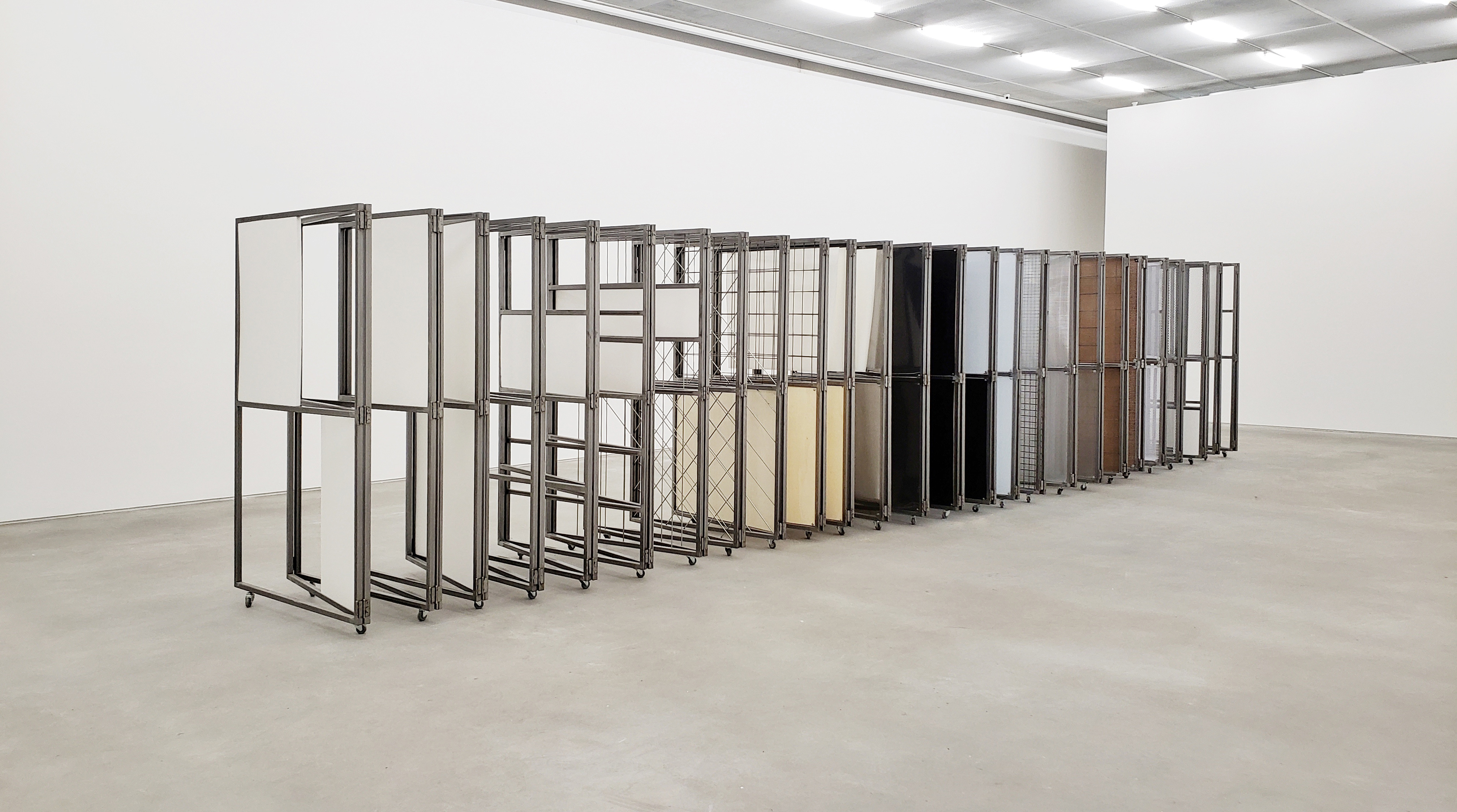
(portuguese text below)
The Portuguese word ressaca translates to either “hangover” or “undertow” in English – in both cases meaning an aftermath or something that produces an effect. The abnormal movement of the undertow of large waves. The physical symptoms that appear when the toxic effects begin to leave the body. The nausea and the storm surge that submerges the coastline. The presentiment of psychological wounds and the promises of change. The currents that drag swimmers and the detritus that gets cast up on the beach. The ressaca foreshadows that what is to come will be different from the past. It is doubt, clouded vision and projection. The exhibition Ressaca is simultaneously a moment of synthesis and a turning point, it is a culmination and a re-beginning. An end, a letting go.
A retrospective look at the artworks and research that precedes Ressaca will find a work whose scope is mainly defined in relation to architecture, especially the modernist trend and its subthemes, specificities, “ideological lapses,” “weaknesses,” and “unfulfilled promises,” among others. Underlying the circumscribable themes there are divergent wishes and interests that sporadically appear, making it hard to delineate relationships of causality between the work and the discourse. The ressaca reconciles such imprecisions that evince the comfort of that “speech,” making them compatible with a definite message, an intelligible critical aim, an end. The ressaca also allows for a momentary undoing of the prescriptive associations or metaphoric analogies, giving rise to an indeterminate and propositional state/space.
A balance between overdetermination and the unforeseen underlies a large part of the production of Lucas Simões. If, on the one hand, his pieces begin with the extreme preciseness of the vectorial grid of CAD (Computer Aided Design) software, on the other, they presuppose the imprecisions of their manual making, the mutation of the material over time, the unpredictability of the contact with the spectator, and other unpredictable aspects. The rigorous planning that goes into the pieces makes these expected/desired unforeseen outcomes all the more powerful. Thus, the “final work” does not represent the instant at which the artist “loses control” of the artwork in face of the contingencies of the real; rather, it denotes merely the development of the happenings that were previously calculated and authorized for the work.(1)
In his large-scale installations, Lucas Simões gives rise to situations where the visitor’s movement through the exhibition space presupposes a reconfiguration of the work, whether by a physical “confrontation” between the viewer and the piece, or by a radical shift in the perception of the work according to the observer’s specific position.(2) As “participation” is nearly inevitable in these works, they avoid the paternalism of an edifying “interactive” experience. In the spatio-temporal experience of Lucas Simões’ installations, the certainty of the design grid becomes a vortex, a labyrinth; (3) it creates places marked by a subliminal and ambiguous tension, between the threatening and the playful, where the distinction between controller and the controlled becomes blurred; it declares its danger of imminent rupture and its precarious balance;4 it refers to the visual vocabulary and experience we inherit from the streets and cites the tension between the idealized notions of space and the reality of its physical manifestation and everyday appropriation.(5) By circulating through the exhibition room, the viewer contributes to the work’s permanent reconfiguration or even its “destruction,”(6) maintaining it in a limbo between ruin and construction.
Although most of Lucas Simões’ works are possible to grasp on an architectural scale, miniaturization and giantism are inherent qualities of his sculptural pieces. Such sculptures are structured based on the intersection of two types of operation: the appropriation of objects and the exploration of determined materials that lead to the creation of new artifacts. Through carefully considered combinations and juxtapositions, Lucas creates compositions that enlarge the “vibrations” of each one of the parts, intensifying the formal limits of each element in order to allow for the emergence of other narratives that are inherent to them but which remain dormant under their “uses.” The exchangeability of scales makes the viewer “gauge” these artworks through an enlargement or miniaturization of his or her own body. The fictional possibility of walking over the topographies (7) or of dwelling in the proto-monuments (8) and buildings molded by Lucas Simões is contradicted by an enclosed dimension the pieces seem to contain, something to which we do not have access, whose existence we can only glimpse and suppose.
The objects (9) featured in Ressaca combine a series of operations recurrent in the artist’s sculptural research – such as the use of light and fragile materials that impose forms on the materials to which they lend solidity, weight and permanence, as well as the importance of gravity, of balance, and of the void – with a set of formal decisions that point to an equation never before seen in Lucas Simões’ practice. But the state of ressacaprevents an interpretative or prescriptive discourse that would “tame” these pieces, since they beckon for a more obscure existence, less subservient to themes and labels. To the infeasibility of conclusions the ressacaadds the certainty of the discourse where the careful planning becomes indeterminate due to anticipated, desired and yet unforeseen outcomes. The end, a letting go.
Bruno de Almeida, August 2018
The notes describe works by Lucas Simões, the titles in bold font correspond to the works in the exhibition Ressaca:
1. Engessados (2014) – fragile plaster sculptures that reinterpret the hinged, manipulatable Bichossculptural series by Lygia Clark as though they were paralyzed [JN3] and fossilized in plaster. The pieces are then arranged on an abrasive surface where the public can manipulate them; the friction between the surface and the plaster wears down the pieces until they completely disappear.
2. “Ressaca” (2018) – Installation in the larger room of Casa Triângulo. Fifty-two metallic panels articulated with one another, each totally or partially closed with material such as steel, PVC, perforated sheets of wood, foam, steel screens, mosquito netting, cellular polycarbonate (which refers to the translucent plane that delimits the entire perimeter of the gallery). Each panel possesses two rotating wheels that allow them to slide on the floor so the set can be reconfigured by the visitors. The 65-meter length of this work corresponds to the dividing line between the terrain of Casa Triângulo and the public space.
3. Caixão Perdido (2012) – A labyrinth whose design results from the decomposition of an orthogonal grid juxtaposed to a space of variable proportions and shapes. The installation occupied a space that had then been recently opened up by breaking down some of the building’s walls. This site-specific work was carried out in the space that is currently that of Pivô, in the Copan Building.
4. Grave Gravidade (2016) – a wall of concrete blocks constructed without foundations, without a structure and where the mortar is substituted by layers of foam. An area of danger is marked off around it because there is a real risk that it might fall over.
5. “quatro cantos entre quatro paredes” (2015) – A project involving a set of installations for the public space, consisting in various compositions of white walls whose arrangements give rise to minimal, labyrinthine paths with an alternation between protected and exposed spaces. The absence of rules, explanations and monitoring makes it possible for the citizens to spontaneously appropriate the space.
6. Recalque diferencial (2015) – The exhibition room’s floor is covered by a thin layer of concrete over a foam “mattress.” The weight of the visitors who enter the space makes the floor crack and sink down momentarily, gradually returning to its original position through the natural reconfiguration of the shape of the foam. Over the course of the exhibition, the floor accumulates the cracks resulting from the paths taken by the visitors through the room.
7. provável horizonte series (2013) – Objects of everyday tactile memory, reproduced in cement and overlain on topographic scale models made of paper.
8. Abismos series (2017) – Concrete objects and reams of paper where the two materials are correlated through relationships of weight, pressure and gravity. The pieces of concrete, with different forms and textures, will eventually present cracks and splits due to the constant mutation of the material and the forces and efforts to which they are submitted. The position of the paper is molded by this rigid structure.
9. The series you text nothing like you look (2018) – A series of sculptures in the other room at Casa Triângulo. The pieces create a dialogue between the material that gives them their body and a series of written messages that inspired their production. Each of the pieces originates based on a phrase, in its original language, which is used in the first part of the artwork’s title. When the piece is finished the artist completes its title with a second line originary from another language chosen according to the reading of the finished artwork.
In this exhibition were also shown pieces from You Text Nothing Like You Look series.
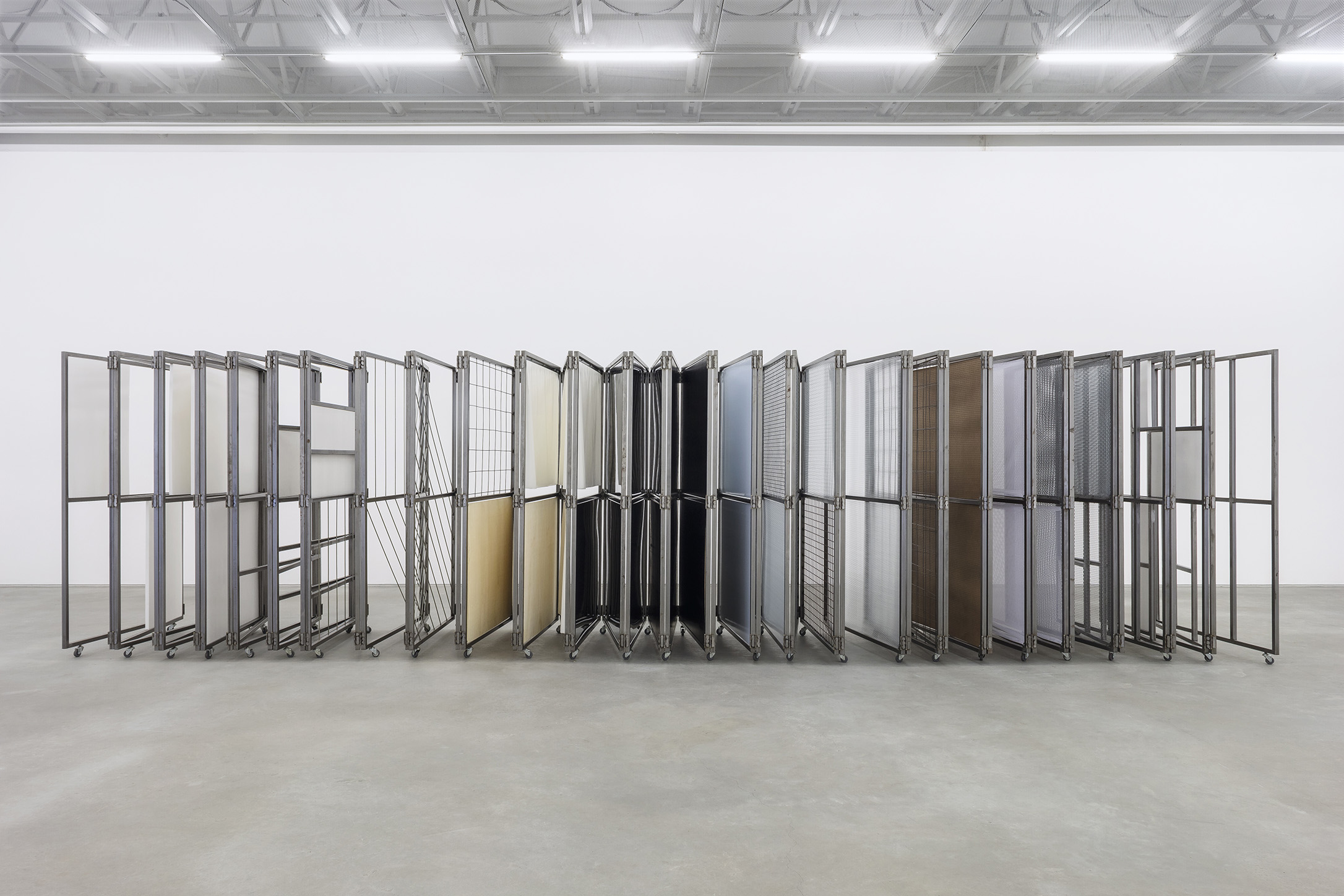


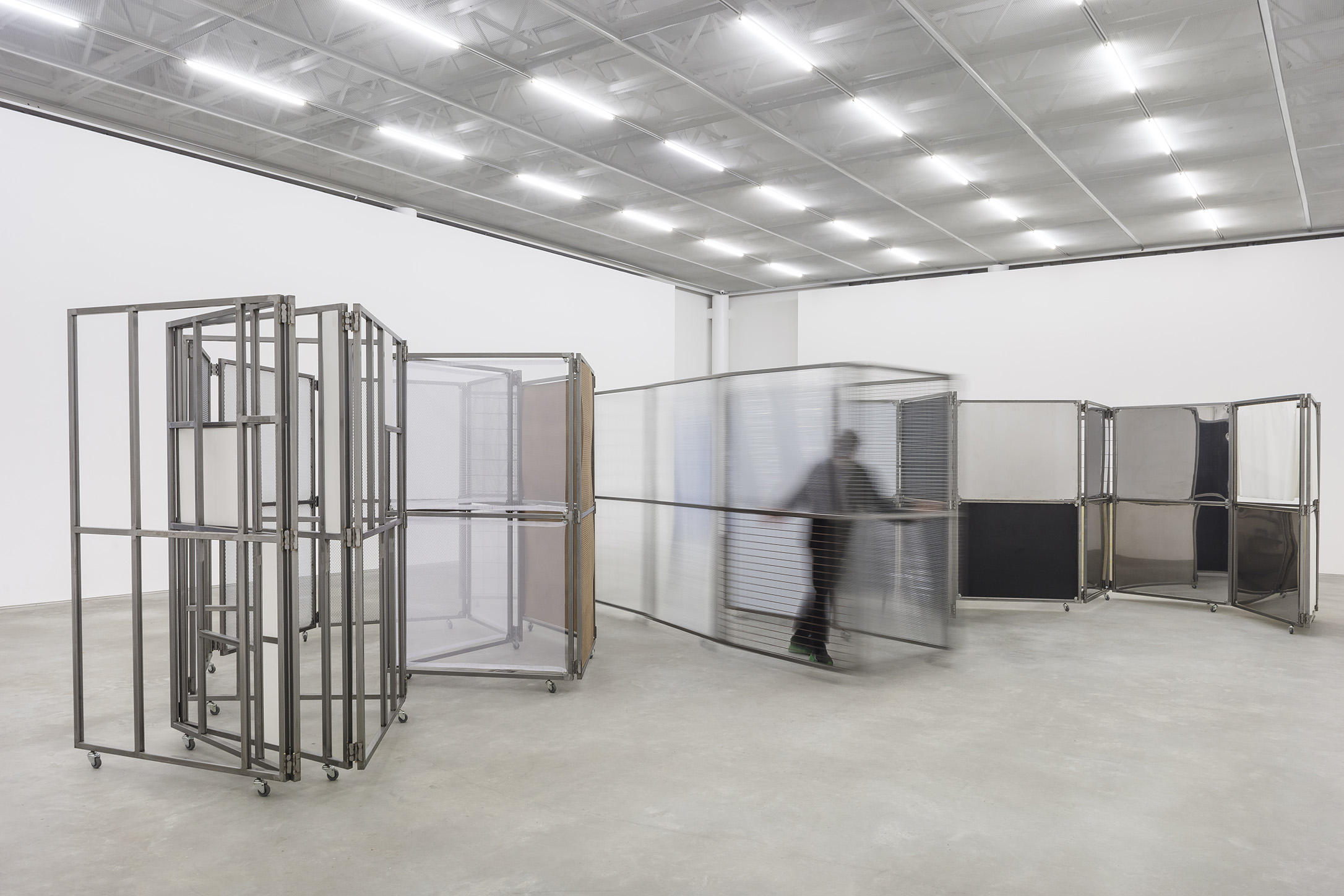

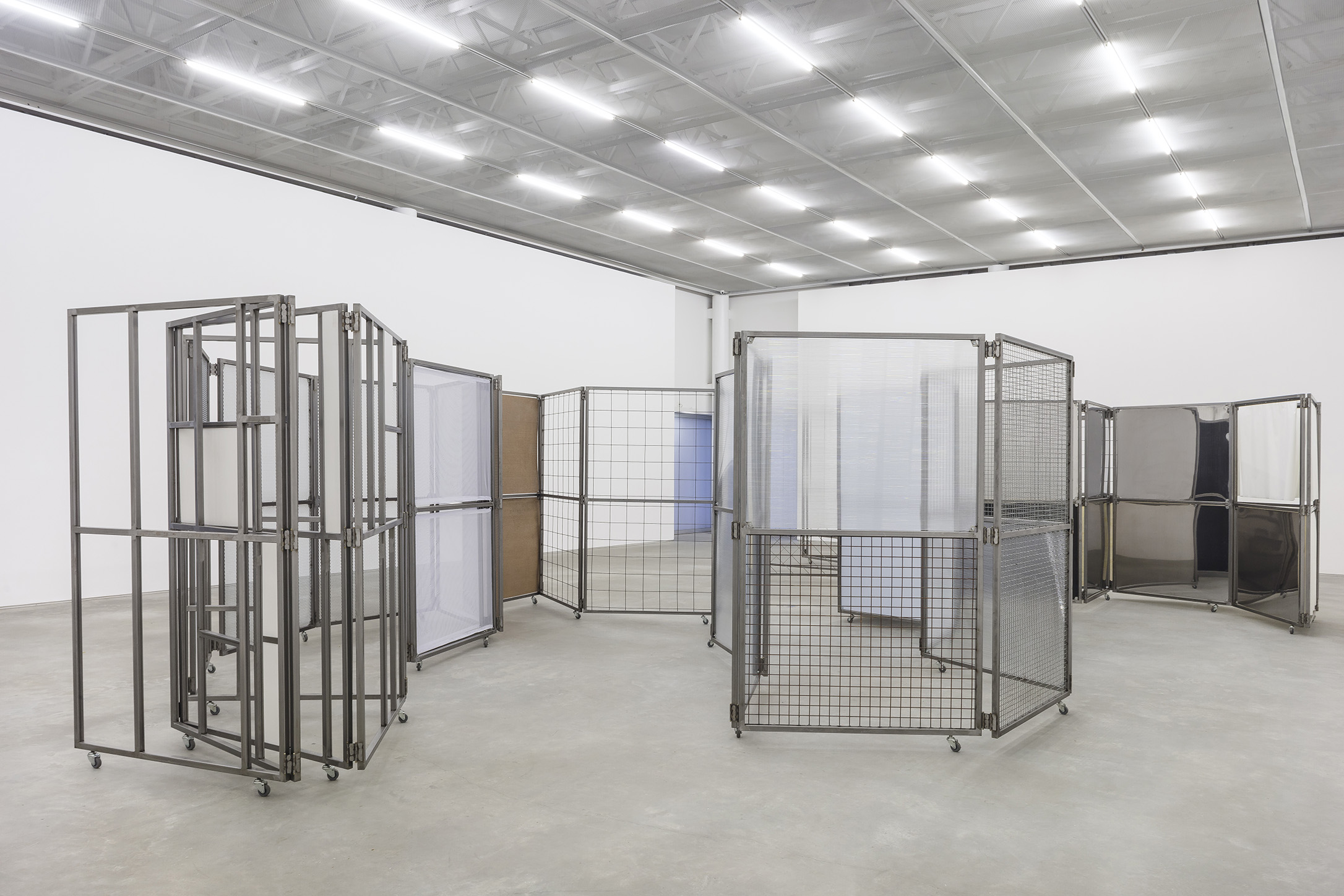
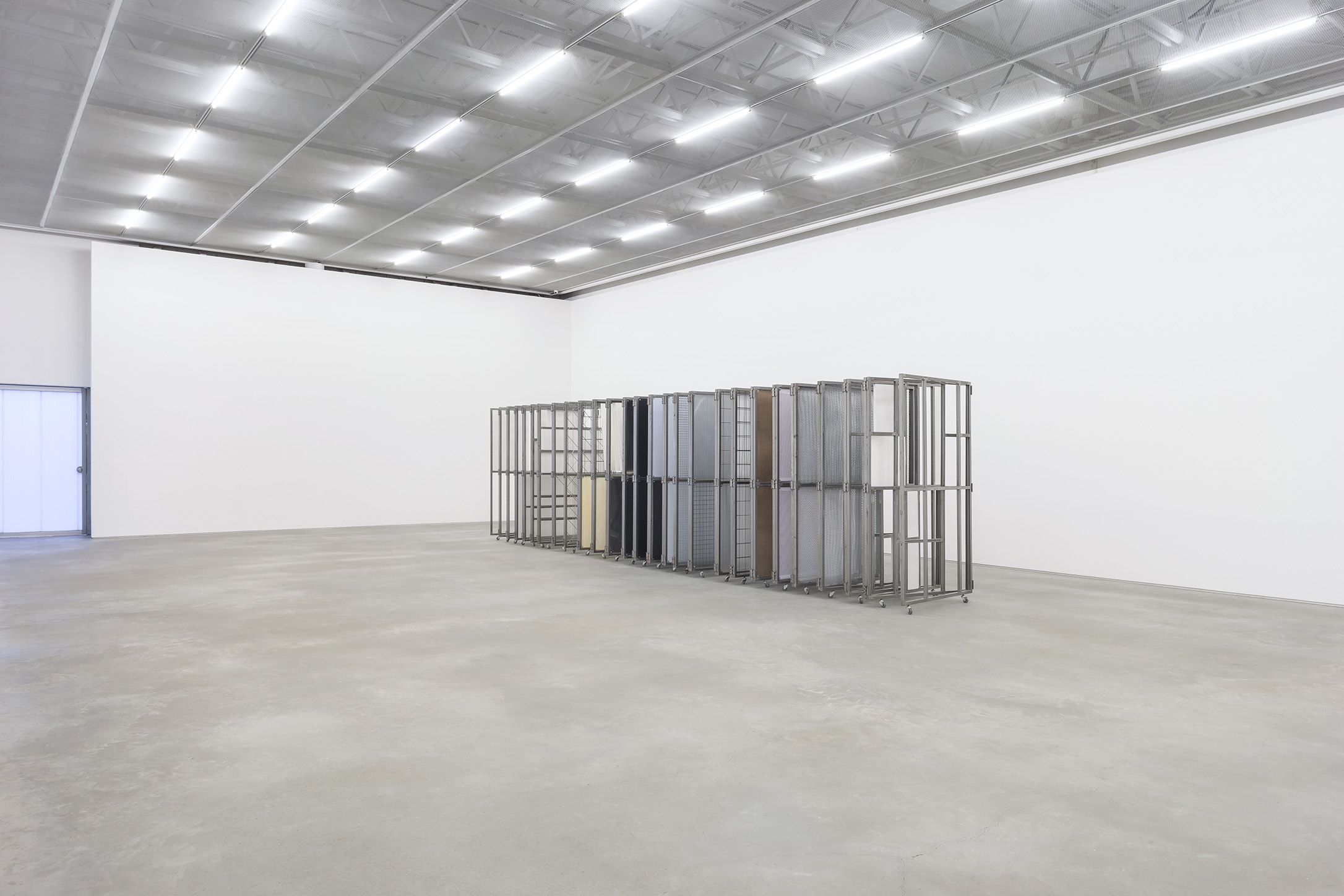

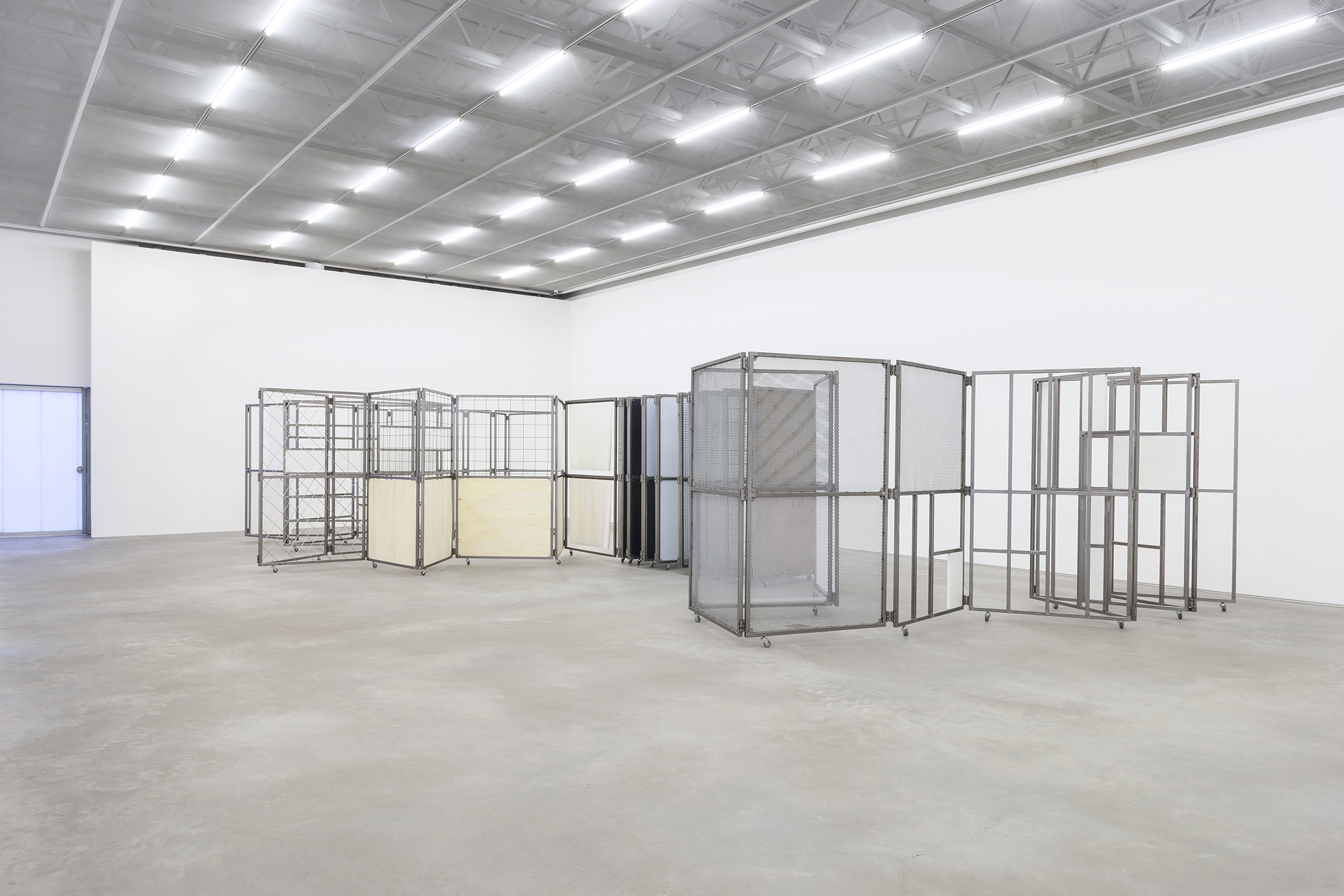

images of the exhibition, Casa Triangulo gallery, São Paulo, Brazil, 2018
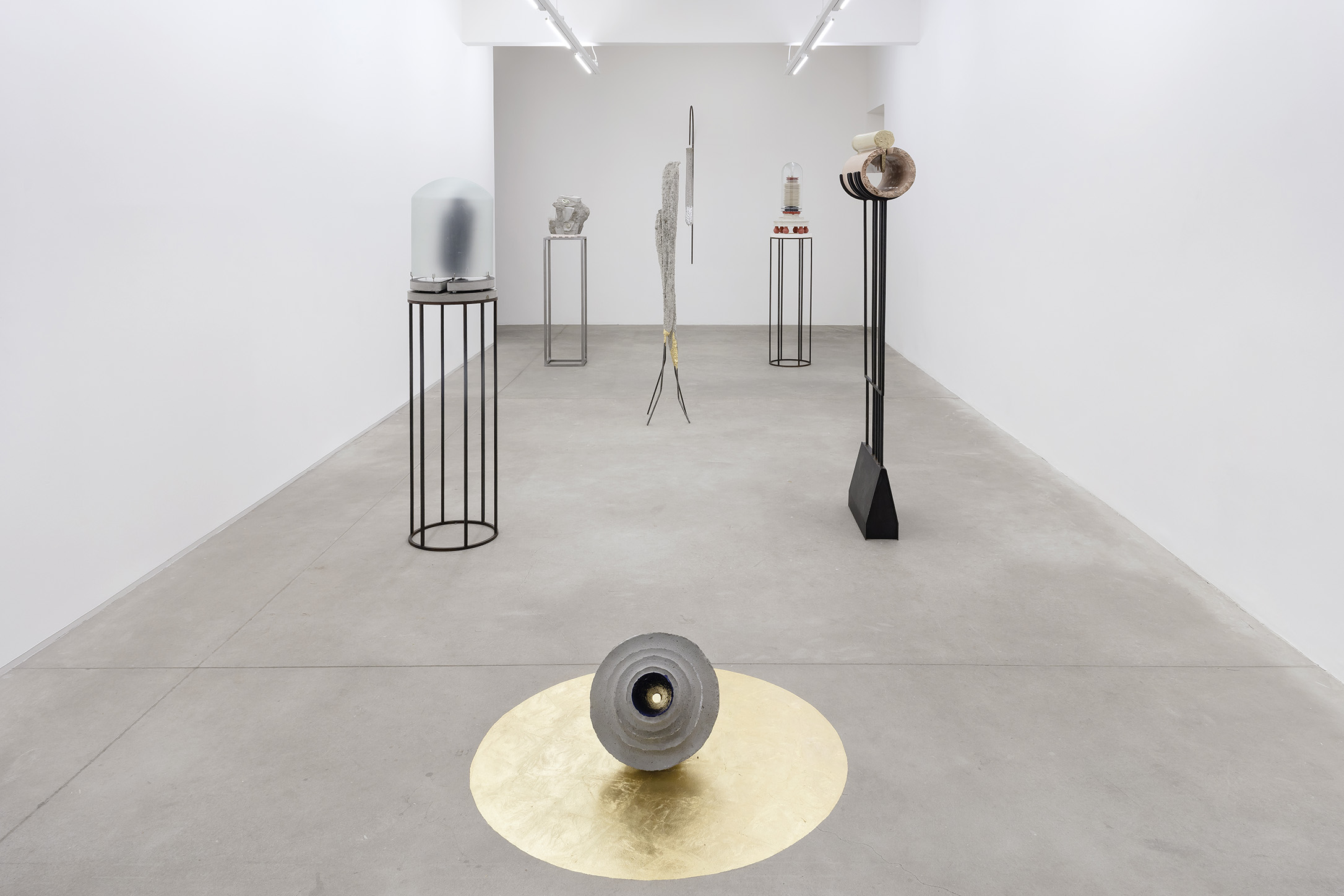
Texto em português
Ressaca é o conjunto de efeitos na sequência de um acontecimento, aquilo que fica ou que produz algo. O movimento anormal de refluxo das ondas. Os sintomas físicos que aparecem quando os efeitos tóxicos começam a abandonar o corpo. A náusea e as vagas que submergem o litoral. Os presságios das mazelas psicológicas e as promessas de mudança. As correntes que tragam banhistas e os detritos que escorrem na praia. A ressaca prenuncia que o porvir não será como o pretérito. É dúvida, visão turva e projeção. “Ressaca” é simultaneamente um momento de síntese e inflexão, é o culminar e o recomeçar. O fim, abandona-se.
Um olhar retrospectivo sobre a obra e pesquisa que antecede “Ressaca” se depara com um trabalho cujo “escopo” é definido majoritariamente em relação à arquitetura, principalmente à vertente Modernista e seus subtemas, especificidades, “lapsos ideológicos”, "fracassos”, “promessas por-cumprir”, entre outros. Aos temas circunscritíveis subjazem vontades e interesses desviantes que aparecem pontualmente, dificultando as relações de causalidade entre o trabalho e o discurso. A ressaca propicia tais inexatidões que evidenciam o conforto daquela “fala” com uma mensagem positivada, uma ambição crítica inteligível, um fim. A ressaca também possibilita um desfazer momentâneo de associações prescritivas ou analogias metafóricas, gerando um estado/espaço de indeterminação e proposição.
O equilíbrio entre hiper-determinação e imprevisto é subjacente a grande parte da produção de Lucas Simões. Se, por um lado, as suas peças começam da exatidão extrema do grid vetorial do CAD (Computer Aided Design), por outro, elas pressupõem as imprecisões da sua feitura manual, a mutação do material ao longo do tempo, a imprevisibilidade do contato com o espectador, entre outras. O grande rigor projetual inerente às peças é aquilo que permite que esses imprevistos-esperáveis/desejáveis sejam potencializados. Deste modo, a “obra finalizada” não representa o instante em que o artista “perde o controle” do trabalho face às contingências do real, ao invés, denota apenas o desenrolar de acontecimentos que foram previamente calculados e outorgados ao trabalho (1).
Nas suas instalações de grande escala, Lucas Simões engendra situações onde o movimento do visitante pelo espaço de exposição pressupõe uma reconfiguração do trabalho; seja ela resultante de um “confronto” físico entre o sujeito e a peça ou de uma mutação radical da percepção do trabalho de acordo com o posicionamento daquele que o observa (2). A quase inevitabilidade da “participação” afasta qualquer paternalismo de uma experiência “interativa” edificante. Na vivência espacio-temporal das instalações de Lucas Simões, a certeza do grid projetual desfaz-se, torna-se vórtice, labirinto (3); cria lugares marcados por uma tensão subliminar e ambígua, entre o ameaçador e o lúdico, onde se confunde o que controla e o que é controlado; declara o seu perigo de ruptura iminente e o seu equilíbrio precário(4); remete ao vocabulário visual e experiência que herdamos das ruas e cita a tensão entre as noções idealizadas do espaço e a realidade de sua manifestação física e apropriação quotidiana (5). Circular pela sala de exposição é contribuir para a permanente reconfiguração ou até mesmo a “destruição” do trabalho (6), mantendo-o num limbo entre a ruína e a construção.
Embora na maioria dos trabalhos de Lucas Simões seja possível apreender uma escala arquitetônica, a miniaturização e o gigantismo são qualidades inerentes às suas peças escultóricas. Tais esculturas estruturam-se a partir da intersecção de dois tipos de operação; a apropriação de objetos e a exploração de determinados materiais que leva à criação de novos artefatos. Através de ponderadas combinações e justaposições, Lucas cria composições que amplificam as “vibrações” de cada uma das partes, intensificando os limites formais de cada elemento, de modo a possibilitar a emergência de outras narrativas que lhes são inerentes mas que permanecem adormecidas sob os seus “usos”. A permutabilidade de escalas faz com que o sujeito “meça” estes trabalhos através de uma ampliação ou miniaturização do seu próprio corpo. A possibilidade fictícia de percorrer as topografias (7) ou de habitar os proto- monumentos (8) e edifícios moldados por Lucas Simões é contrariada por uma dimensão encerrada que as peças parecem conter, algo a que não temos acesso, que apenas podemos entrever e supor.
Os objetos que “Ressaca” traz (9), conjugam uma série de operações recorrentes na pesquisa escultórica do artista (tais como o uso de materiais leves e frágeis que impõem formas aos materiais aos quais associamos solidez, peso e permanência; a importância da gravidade, do equilíbrio e do vazio, entre outros) com um conjunto de decisões formais que apontam para uma equação até então inédita na prática de Lucas Simões. Mas o estado de ressaca impossibilita um discurso interpretativo ou prescritivo que venha “domesticar” tais peças, já que elas próprias reivindicam uma existência mais opaca e menos subserviente a temas e rótulos. À inviabilidade de conclusões, a ressaca apõe a certeza do discurso que dá espaço à indeterminação projetiva e que antecipa e incita imprevistos desejáveis. O fim, abandona-se.
texto de Bruno de Almeida, 2018
As notas descrevem trabalhos de Lucas Simões, os títulos destacados correspondem às obras da exposição “Ressaca”:
1. Engessados (2014) - Esculturas de gesso frágil que reinterpretam a obra “Bichos” de Lygia Clark como se estes estivessem paralisados e fossilizados no gesso. As peças estão dispostas numa superfície abrasiva onde público pode manipula-las, o atrito entre a superfície e o gesso desgasta as peças até ao seu completo desaparecimento.
2. Ressaca (2018) – Instalação na sala maior da Casa Triângulo. 52 painéis metálicos articulados entre si, cada um é total ou parcialmente encerrado com materiais tais como: aço, PVC, chapa perfurada de madeira, espuma, telas de aço, tela de mosquiteiro, policarbonato alveolar (que remete ao plano translúcido que delimita todo o perímetro da galeria). Cada painel possui 2 rodízios giratórios fazendo-os deslizar sobre o chão e garantindo que o conjunto possa ser reconfigurado pelos visitantes. Os 65 metros de comprimento deste trabalho correspondem à linha de divisão entre o terreno da Casa Triângulo e o espaço público.
3. Caixão Perdido (2012) – Labirinto cuja planta resulta da decomposição de um grid ortogonal justaposto a um espaço de formas e cotas variáveis. A instalação ocupa um espaço então recém-descoberto resultante da quebra de algumas paredes do edifício. Site-specific realizado no atual espaço do Pivô, Edifício Copan.
4. Grave Gravidade (2016) - Muro de blocos de concreto construído sem fundações, sem estrutura e onde o rejunte é substituído por camadas de espuma macia. Uma área de perigo é delimitada ao seu redor pois possui um risco real de desabamento.
5. quatro cantos entre quatro paredes (2015) - Projeto de um conjunto de instalações para o espaço público que consiste na em diversas composição de muros brancos cujas disposições geram percursos mínimos e labirínticos com alternância entre espaços protegidos e expostos. A ausência de regras, explicações e monitoramento, dá lugar à possibilidade de uma apropriação franca do espaço pelos cidadãos.
6. Recalque diferencial (2015) - O chão da sala expositiva é coberto com uma camada fina de concreto sobre um “colchão” de espuma. O peso daqueles que entram no espaço faz com que este chão rache e afunde momentaneamente, voltando gradualmente à sua posição original através da reconfiguração natural da forma da espuma. Ao longo da exposição o chão acumula as rachaduras resultante dos percursos dos visitantes pela sala.
7. Série provável horizonte (2013) - Objetos de memória tátil, cotidiana, replicados em cimento e sobrepostos em maquetes topográficas de papel.
8. Série Abismos (2017) – Objetos de concreto e resmas de folhas de papel onde a correlação de ambos materiais se dá através de relações de peso, pressão e gravidade. As peças de concreto, com diferentes formas e texturas, eventualmente irão apresentar rachaduras e trincas dadas pela constante mutação do material e pelas forças e esforços aos quais estão submetidos. A posição do papel é moldada por essa estrutura rígida.
9. Série you text nothing like you look (2018) - Série de esculturas na sala menor da Casa Triângulo. As peças criam um diálogo entre a matéria que lhes dá corpo e uma série de versos que inspiram a sua produção. Cada uma das peças se origina a partir de uma frase, em sua língua original, que é usada na primeira parte do título do trabalho. Quando a peça é finalizada o artista completa o seu título com um segundo verso em outra língua cuja escolha advém da leitura do trabalho acabado.
Ressaca é o conjunto de efeitos na sequência de um acontecimento, aquilo que fica ou que produz algo. O movimento anormal de refluxo das ondas. Os sintomas físicos que aparecem quando os efeitos tóxicos começam a abandonar o corpo. A náusea e as vagas que submergem o litoral. Os presságios das mazelas psicológicas e as promessas de mudança. As correntes que tragam banhistas e os detritos que escorrem na praia. A ressaca prenuncia que o porvir não será como o pretérito. É dúvida, visão turva e projeção. “Ressaca” é simultaneamente um momento de síntese e inflexão, é o culminar e o recomeçar. O fim, abandona-se.
Um olhar retrospectivo sobre a obra e pesquisa que antecede “Ressaca” se depara com um trabalho cujo “escopo” é definido majoritariamente em relação à arquitetura, principalmente à vertente Modernista e seus subtemas, especificidades, “lapsos ideológicos”, "fracassos”, “promessas por-cumprir”, entre outros. Aos temas circunscritíveis subjazem vontades e interesses desviantes que aparecem pontualmente, dificultando as relações de causalidade entre o trabalho e o discurso. A ressaca propicia tais inexatidões que evidenciam o conforto daquela “fala” com uma mensagem positivada, uma ambição crítica inteligível, um fim. A ressaca também possibilita um desfazer momentâneo de associações prescritivas ou analogias metafóricas, gerando um estado/espaço de indeterminação e proposição.
O equilíbrio entre hiper-determinação e imprevisto é subjacente a grande parte da produção de Lucas Simões. Se, por um lado, as suas peças começam da exatidão extrema do grid vetorial do CAD (Computer Aided Design), por outro, elas pressupõem as imprecisões da sua feitura manual, a mutação do material ao longo do tempo, a imprevisibilidade do contato com o espectador, entre outras. O grande rigor projetual inerente às peças é aquilo que permite que esses imprevistos-esperáveis/desejáveis sejam potencializados. Deste modo, a “obra finalizada” não representa o instante em que o artista “perde o controle” do trabalho face às contingências do real, ao invés, denota apenas o desenrolar de acontecimentos que foram previamente calculados e outorgados ao trabalho (1).
Nas suas instalações de grande escala, Lucas Simões engendra situações onde o movimento do visitante pelo espaço de exposição pressupõe uma reconfiguração do trabalho; seja ela resultante de um “confronto” físico entre o sujeito e a peça ou de uma mutação radical da percepção do trabalho de acordo com o posicionamento daquele que o observa (2). A quase inevitabilidade da “participação” afasta qualquer paternalismo de uma experiência “interativa” edificante. Na vivência espacio-temporal das instalações de Lucas Simões, a certeza do grid projetual desfaz-se, torna-se vórtice, labirinto (3); cria lugares marcados por uma tensão subliminar e ambígua, entre o ameaçador e o lúdico, onde se confunde o que controla e o que é controlado; declara o seu perigo de ruptura iminente e o seu equilíbrio precário(4); remete ao vocabulário visual e experiência que herdamos das ruas e cita a tensão entre as noções idealizadas do espaço e a realidade de sua manifestação física e apropriação quotidiana (5). Circular pela sala de exposição é contribuir para a permanente reconfiguração ou até mesmo a “destruição” do trabalho (6), mantendo-o num limbo entre a ruína e a construção.
Embora na maioria dos trabalhos de Lucas Simões seja possível apreender uma escala arquitetônica, a miniaturização e o gigantismo são qualidades inerentes às suas peças escultóricas. Tais esculturas estruturam-se a partir da intersecção de dois tipos de operação; a apropriação de objetos e a exploração de determinados materiais que leva à criação de novos artefatos. Através de ponderadas combinações e justaposições, Lucas cria composições que amplificam as “vibrações” de cada uma das partes, intensificando os limites formais de cada elemento, de modo a possibilitar a emergência de outras narrativas que lhes são inerentes mas que permanecem adormecidas sob os seus “usos”. A permutabilidade de escalas faz com que o sujeito “meça” estes trabalhos através de uma ampliação ou miniaturização do seu próprio corpo. A possibilidade fictícia de percorrer as topografias (7) ou de habitar os proto- monumentos (8) e edifícios moldados por Lucas Simões é contrariada por uma dimensão encerrada que as peças parecem conter, algo a que não temos acesso, que apenas podemos entrever e supor.
Os objetos que “Ressaca” traz (9), conjugam uma série de operações recorrentes na pesquisa escultórica do artista (tais como o uso de materiais leves e frágeis que impõem formas aos materiais aos quais associamos solidez, peso e permanência; a importância da gravidade, do equilíbrio e do vazio, entre outros) com um conjunto de decisões formais que apontam para uma equação até então inédita na prática de Lucas Simões. Mas o estado de ressaca impossibilita um discurso interpretativo ou prescritivo que venha “domesticar” tais peças, já que elas próprias reivindicam uma existência mais opaca e menos subserviente a temas e rótulos. À inviabilidade de conclusões, a ressaca apõe a certeza do discurso que dá espaço à indeterminação projetiva e que antecipa e incita imprevistos desejáveis. O fim, abandona-se.
texto de Bruno de Almeida, 2018
As notas descrevem trabalhos de Lucas Simões, os títulos destacados correspondem às obras da exposição “Ressaca”:
1. Engessados (2014) - Esculturas de gesso frágil que reinterpretam a obra “Bichos” de Lygia Clark como se estes estivessem paralisados e fossilizados no gesso. As peças estão dispostas numa superfície abrasiva onde público pode manipula-las, o atrito entre a superfície e o gesso desgasta as peças até ao seu completo desaparecimento.
2. Ressaca (2018) – Instalação na sala maior da Casa Triângulo. 52 painéis metálicos articulados entre si, cada um é total ou parcialmente encerrado com materiais tais como: aço, PVC, chapa perfurada de madeira, espuma, telas de aço, tela de mosquiteiro, policarbonato alveolar (que remete ao plano translúcido que delimita todo o perímetro da galeria). Cada painel possui 2 rodízios giratórios fazendo-os deslizar sobre o chão e garantindo que o conjunto possa ser reconfigurado pelos visitantes. Os 65 metros de comprimento deste trabalho correspondem à linha de divisão entre o terreno da Casa Triângulo e o espaço público.
3. Caixão Perdido (2012) – Labirinto cuja planta resulta da decomposição de um grid ortogonal justaposto a um espaço de formas e cotas variáveis. A instalação ocupa um espaço então recém-descoberto resultante da quebra de algumas paredes do edifício. Site-specific realizado no atual espaço do Pivô, Edifício Copan.
4. Grave Gravidade (2016) - Muro de blocos de concreto construído sem fundações, sem estrutura e onde o rejunte é substituído por camadas de espuma macia. Uma área de perigo é delimitada ao seu redor pois possui um risco real de desabamento.
5. quatro cantos entre quatro paredes (2015) - Projeto de um conjunto de instalações para o espaço público que consiste na em diversas composição de muros brancos cujas disposições geram percursos mínimos e labirínticos com alternância entre espaços protegidos e expostos. A ausência de regras, explicações e monitoramento, dá lugar à possibilidade de uma apropriação franca do espaço pelos cidadãos.
6. Recalque diferencial (2015) - O chão da sala expositiva é coberto com uma camada fina de concreto sobre um “colchão” de espuma. O peso daqueles que entram no espaço faz com que este chão rache e afunde momentaneamente, voltando gradualmente à sua posição original através da reconfiguração natural da forma da espuma. Ao longo da exposição o chão acumula as rachaduras resultante dos percursos dos visitantes pela sala.
7. Série provável horizonte (2013) - Objetos de memória tátil, cotidiana, replicados em cimento e sobrepostos em maquetes topográficas de papel.
8. Série Abismos (2017) – Objetos de concreto e resmas de folhas de papel onde a correlação de ambos materiais se dá através de relações de peso, pressão e gravidade. As peças de concreto, com diferentes formas e texturas, eventualmente irão apresentar rachaduras e trincas dadas pela constante mutação do material e pelas forças e esforços aos quais estão submetidos. A posição do papel é moldada por essa estrutura rígida.
9. Série you text nothing like you look (2018) - Série de esculturas na sala menor da Casa Triângulo. As peças criam um diálogo entre a matéria que lhes dá corpo e uma série de versos que inspiram a sua produção. Cada uma das peças se origina a partir de uma frase, em sua língua original, que é usada na primeira parte do título do trabalho. Quando a peça é finalizada o artista completa o seu título com um segundo verso em outra língua cuja escolha advém da leitura do trabalho acabado.
